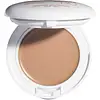Clean Fresh Primer, Color Correcting Serum and Moisturizer
Color: Redness Neutralizer, FairWhat's inside
What's inside
 Key Ingredients
Key Ingredients

 Benefits
Benefits

 Concerns
Concerns

 Ingredients Side-by-side
Ingredients Side-by-side

Water
Skin ConditioningDimethicone
EmollientDicaprylyl Carbonate
EmollientGlycerin
HumectantNiacinamide
SmoothingPropylene Glycol
HumectantBis-PEG/PPG-20/5 PEG/PPG-20/5 Dimethicone
EmulsifyingMethoxy PEG/PPG-25/4 Dimethicone
EmulsifyingHydroxyethyl Acrylate/Sodium Acryloyldimethyl Taurate Copolymer
Emulsion StabilisingCaprylic/Capric Triglyceride
MaskingCaprylyl Glycol
EmollientHydroxyacetophenone
AntioxidantPersea Gratissima Oil
Skin ConditioningHydrogenated Vegetable Oil
EmollientXanthan Gum
EmulsifyingDicaprylyl Ether
EmollientBisabolol
MaskingPolysorbate 60
EmulsifyingSorbitan Isostearate
EmulsifyingTriethoxycaprylylsilane
Trisodium Ethylenediamine Disuccinate
Tri (Polyglyceryl-3/Lauryl) Hydrogenated Trilinoleate
EmulsifyingCetyl PEG/PPG-10/1 Dimethicone
EmulsifyingCeramide NP
Skin ConditioningSodium Hydroxide
BufferingTocopherol
AntioxidantPentaerythrityl Tetra-Di-T-Butyl Hydroxyhydrocinnamate
AntioxidantFarnesol
PerfumingCI 77891
Cosmetic ColorantIron Oxides
CI 77007
Cosmetic ColorantWater, Dimethicone, Dicaprylyl Carbonate, Glycerin, Niacinamide, Propylene Glycol, Bis-PEG/PPG-20/5 PEG/PPG-20/5 Dimethicone, Methoxy PEG/PPG-25/4 Dimethicone, Hydroxyethyl Acrylate/Sodium Acryloyldimethyl Taurate Copolymer, Caprylic/Capric Triglyceride, Caprylyl Glycol, Hydroxyacetophenone, Persea Gratissima Oil, Hydrogenated Vegetable Oil, Xanthan Gum, Dicaprylyl Ether, Bisabolol, Polysorbate 60, Sorbitan Isostearate, Triethoxycaprylylsilane, Trisodium Ethylenediamine Disuccinate, Tri (Polyglyceryl-3/Lauryl) Hydrogenated Trilinoleate, Cetyl PEG/PPG-10/1 Dimethicone, Ceramide NP, Sodium Hydroxide, Tocopherol, Pentaerythrityl Tetra-Di-T-Butyl Hydroxyhydrocinnamate, Farnesol, CI 77891, Iron Oxides, CI 77007
Titanium Dioxide 13.7%
Cosmetic ColorantZinc Oxide 4.9%
Cosmetic ColorantDimethicone
EmollientHydrogenated Polyisobutene
EmollientPhenyl Trimethicone
Skin ConditioningIsodecyl Neopentanoate
EmollientSqualane
EmollientTalc
AbrasiveEthylhexyl Hydroxystearate
EmollientPolyethylene
AbrasiveIron Oxides
Polymethyl Methacrylate
Silica
AbrasivePolyglyceryl-3 Diisostearate
EmulsifyingAlumina
AbrasiveStearic Acid
CleansingWater
Skin ConditioningBeeswax
Emulsion StabilisingBHT
AntioxidantCaprylic/Capric Triglyceride
MaskingMicrocrystalline Wax
Emulsion StabilisingPhenoxyethanol
PreservativeTocopherol
AntioxidantTocopheryl Glucoside
EmollientTribehenin
EmollientTriethoxycaprylylsilane
CI 77891
Cosmetic ColorantCI 77492
Cosmetic ColorantCI 77491
Cosmetic ColorantCI 77499
Cosmetic ColorantTitanium Dioxide 13.7%, Zinc Oxide 4.9%, Dimethicone, Hydrogenated Polyisobutene, Phenyl Trimethicone, Isodecyl Neopentanoate, Squalane, Talc, Ethylhexyl Hydroxystearate, Polyethylene, Iron Oxides, Polymethyl Methacrylate, Silica, Polyglyceryl-3 Diisostearate, Alumina, Stearic Acid, Water, Beeswax, BHT, Caprylic/Capric Triglyceride, Microcrystalline Wax, Phenoxyethanol, Tocopherol, Tocopheryl Glucoside, Tribehenin, Triethoxycaprylylsilane, CI 77891, CI 77492, CI 77491, CI 77499
Ingredients Explained
These ingredients are found in both products.
Ingredients higher up in an ingredient list are typically present in a larger amount.
This ingredient is an emollient, solvent, and texture enhancer. It is considered a skin-softener by helping the skin prevent moisture loss.
It helps thicken a product's formula and makes it easier to spread by dissolving clumping compounds.
Caprylic Triglyceride is made by combining glycerin with coconut oil, forming a clear liquid.
While there is an assumption Caprylic Triglyceride can clog pores due to it being derived from coconut oil, there is no research supporting this.
Learn more about Caprylic/Capric TriglycerideCi 77891 is a white pigment from Titanium dioxide. It is naturally found in minerals such as rutile and ilmenite.
It's main function is to add a white color to cosmetics. It can also be mixed with other colors to create different shades.
Ci 77891 is commonly found in sunscreens due to its ability to block UV rays.
Learn more about CI 77891Dimethicone is a type of synthetic silicone created from natural materials such as quartz.
What it does:
Dimethicone comes in different viscosities:
Depending on the viscosity, dimethicone has different properties.
Ingredients lists don't always show which type is used, so we recommend reaching out to the brand if you have questions about the viscosity.
This ingredient is unlikely to cause irritation because it does not get absorbed into skin. However, people with silicone allergies should be careful about using this ingredient.
Note: Dimethicone may contribute to pilling. This is because it is not oil or water soluble, so pilling may occur when layered with products. When mixed with heavy oils in a formula, the outcome is also quite greasy.
Learn more about DimethiconeTocopherol (also known as Vitamin E) is a common antioxidant used to help protect the skin from free-radicals and strengthen the skin barrier. It's also fat soluble - this means our skin is great at absorbing it.
Vitamin E also helps keep your natural skin lipids healthy. Your lipid skin barrier naturally consists of lipids, ceramides, and fatty acids. Vitamin E offers extra protection for your skin’s lipid barrier, keeping your skin healthy and nourished.
Another benefit is a bit of UV protection. Vitamin E helps reduce the damage caused by UVB rays. (It should not replace your sunscreen). Combining it with Vitamin C can decrease sunburned cells and hyperpigmentation after UV exposure.
You might have noticed Vitamin E + C often paired together. This is because it is great at stabilizing Vitamin C. Using the two together helps increase the effectiveness of both ingredients.
There are often claims that Vitamin E can reduce/prevent scarring, but these claims haven't been confirmed by scientific research.
Learn more about TocopherolTriethoxycaprylylsilane is a silicone used to bind and stabilize ingredients.
As an emulsifier, it helps prevent ingredients from separating. This can help elongate the shelf life of products.
Triethoxycaprylylsilane is often used to coat mineral sunscreens ingredients to help give a better feel. It also helps reduce oxidative stress in sunscreens.
Learn more about TriethoxycaprylylsilaneWater. It's the most common cosmetic ingredient of all. You'll usually see it at the top of ingredient lists, meaning that it makes up the largest part of the product.
So why is it so popular? Water most often acts as a solvent - this means that it helps dissolve other ingredients into the formulation.
You'll also recognize water as that liquid we all need to stay alive. If you see this, drink a glass of water. Stay hydrated!
Learn more about WaterThis ingredient is a combination of red, black, and yellow iron oxide pigments. This combination of colors is usually found in foundation, because it results in a "skin" color.